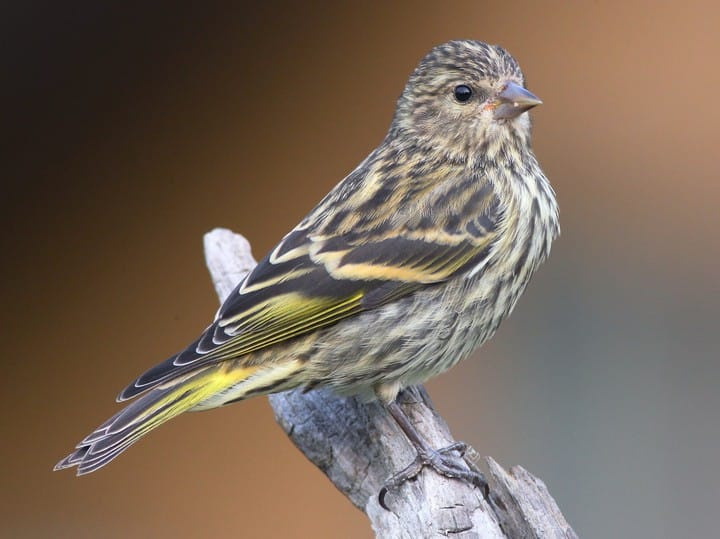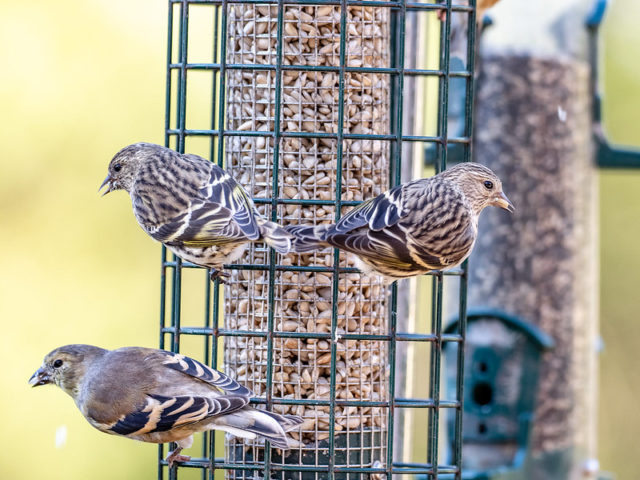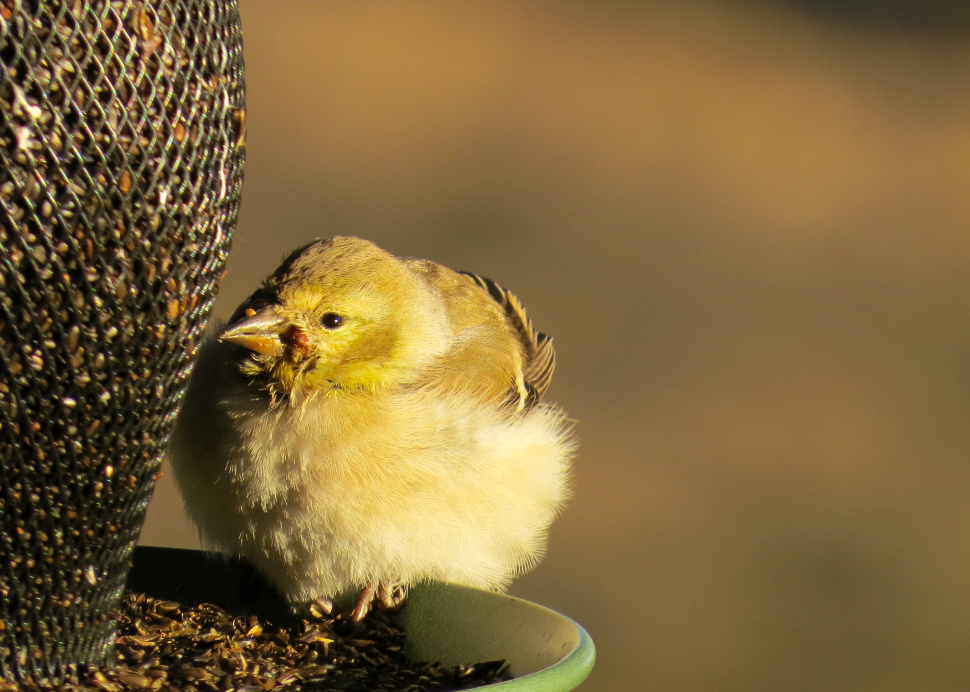idfg-cliess
Turn your backyard into a bird B&B with these helpful wintertime bird-feeding tips
We all know that neighbor that takes bird feeding to Olympic games-level extremes. With tree limbs sagging under the weight of countless feeders and a back lawn that looks like it was ripped straight from Augusta Country Club, they stand out on their back porch with arms outstretched as a myriad of birds swoop in to feed directly from their palms.
That may be a bit of an exaggeration, but you don’t need to be Snow White to attract backyard birds. Many species — including finches, chickadees, jays, nuthatches, sparrows, doves and more — may very well settle on your backyard bed and breakfast with a proper bird-feeding setup this winter.

Usually, feeding wild animals is not a smart move. Feeding birds, however, is a special case, since they don’t often become dependent on feeders alone, and instead use feeders to supplement their daily natural diet. Winter feeding also gives a little assistance to our feathered friends during the harsh, colder months.
Here are a few ways to spice up your bird-feeding buffet and enjoy an enchanting opportunity to observe wildlife right in your own backyard.
Seed. It’s what’s for dinner
Before you go hanging your feeder (or feeders) all across your backyard, you’ll need some seed. Depending on the types of birds you’re hoping to attract, there are many feed and feeder options available. For instance, hanging-style feeders can attract songbirds, such as house finches, chickadee, jays, nuthatches and others. Thistle feeders can bring goldfinches, siskins and house finches, and suet can attract woodpeckers, chickadees and nuthatches.
There are many kinds of birdseed out there on the market. Be sure to source your birdseed from reputable sources to avoid dust, insects, weed seeds or any other impurities from making their way into your feeder. Black-oil sunflower seed is a favorite of many species. Millet and cracked corn are favorites for many ground-feeding birds. Finches and siskins love nyjer thistle.
To avoid freeloaders like squirrels, rats and mice ruining your supply, store birdseed in tight, waterproof containers. This will also help prevent mold.

Feeder placement
Birds don’t have the same pleasures that we do when it comes to drive-thru windows. Placing a bird feeder too close to hazards can end up doing more harm than good. Avoid placing feeders near windows or doors, and keep placement height and accessibility in mind. Predators such as hawks or free-ranging house cats can quickly become uninvited backyard dinner guests when feeders are put out in the open or near low-hanging ledges.
Wash it all down
A hearty meal wouldn’t be complete without a drink. Birds utilize birdbaths throughout the year not only to stay clean but to keep themselves hydrated – a luxury we humans should not try in our baths at home.
If possible, include a birdbath in your backyard bed and breakfast. There are several types on the market, but you can’t go wrong with a simple clay potting saucer.
This time of year, however, it might be a little troublesome keeping that bath ice-free. There are a couple solutions, including special birdbath heaters, to help keep their baths from freezing over. And no, they don’t come with little mini Whirlpool jets and colored LED lights.
Sanitation
A bird’s bath or feeder only does its job when it’s clean. Imagine inviting over the whole cul-de-sac for a hot tub party and leaving the chlorine float in the garage. It’s very important that backyard bird enthusiasts keep their feeders and birdbaths tidy and disinfect at least once a month to prevent the spreading of diseases.
Along those lines, aim for using perch-style feeders rather than open, saucer-style feeders. Because of their openness and contamination from bird feces, open feeders and baths can become a breeding ground for disease.

To clean your feeders, make a household bleach solution using one part household bleach mixed with nine parts lukewarm water. Make enough solution to immerse an empty, cleaned feeder completely for two to three minutes, then air dry.
No beak, no feathers, no service
Remember that feeding wildlife (other than birds) is not recommended. Birds are unique in that they don’t solely rely or become hooked on free, backyard birdseed. The same cannot be said about other wildlife. If food set out for birds is being eaten by other wildlife, move the feeder to a safe location or discontinue feeding.
Feeding birds is a gratifying experience that can be enjoyed by anyone. So pull out the binoculars and the bird-watching guide and enjoy this simple pastime all year round right from the comfort of your backyard.
That may be a bit of an exaggeration, but you don’t need to be Snow White to attract backyard birds. Many species — including finches, chickadees, jays, nuthatches, sparrows, doves and more — may very well settle on your backyard bed and breakfast with a proper bird-feeding setup this winter.

Usually, feeding wild animals is not a smart move. Feeding birds, however, is a special case, since they don’t often become dependent on feeders alone, and instead use feeders to supplement their daily natural diet. Winter feeding also gives a little assistance to our feathered friends during the harsh, colder months.
Here are a few ways to spice up your bird-feeding buffet and enjoy an enchanting opportunity to observe wildlife right in your own backyard.
Seed. It’s what’s for dinner
Before you go hanging your feeder (or feeders) all across your backyard, you’ll need some seed. Depending on the types of birds you’re hoping to attract, there are many feed and feeder options available. For instance, hanging-style feeders can attract songbirds, such as house finches, chickadee, jays, nuthatches and others. Thistle feeders can bring goldfinches, siskins and house finches, and suet can attract woodpeckers, chickadees and nuthatches.
There are many kinds of birdseed out there on the market. Be sure to source your birdseed from reputable sources to avoid dust, insects, weed seeds or any other impurities from making their way into your feeder. Black-oil sunflower seed is a favorite of many species. Millet and cracked corn are favorites for many ground-feeding birds. Finches and siskins love nyjer thistle.
To avoid freeloaders like squirrels, rats and mice ruining your supply, store birdseed in tight, waterproof containers. This will also help prevent mold.

Feeder placement
Birds don’t have the same pleasures that we do when it comes to drive-thru windows. Placing a bird feeder too close to hazards can end up doing more harm than good. Avoid placing feeders near windows or doors, and keep placement height and accessibility in mind. Predators such as hawks or free-ranging house cats can quickly become uninvited backyard dinner guests when feeders are put out in the open or near low-hanging ledges.
Wash it all down
A hearty meal wouldn’t be complete without a drink. Birds utilize birdbaths throughout the year not only to stay clean but to keep themselves hydrated – a luxury we humans should not try in our baths at home.
If possible, include a birdbath in your backyard bed and breakfast. There are several types on the market, but you can’t go wrong with a simple clay potting saucer.
This time of year, however, it might be a little troublesome keeping that bath ice-free. There are a couple solutions, including special birdbath heaters, to help keep their baths from freezing over. And no, they don’t come with little mini Whirlpool jets and colored LED lights.
Sanitation
A bird’s bath or feeder only does its job when it’s clean. Imagine inviting over the whole cul-de-sac for a hot tub party and leaving the chlorine float in the garage. It’s very important that backyard bird enthusiasts keep their feeders and birdbaths tidy and disinfect at least once a month to prevent the spreading of diseases.
Along those lines, aim for using perch-style feeders rather than open, saucer-style feeders. Because of their openness and contamination from bird feces, open feeders and baths can become a breeding ground for disease.

To clean your feeders, make a household bleach solution using one part household bleach mixed with nine parts lukewarm water. Make enough solution to immerse an empty, cleaned feeder completely for two to three minutes, then air dry.
No beak, no feathers, no service
Remember that feeding wildlife (other than birds) is not recommended. Birds are unique in that they don’t solely rely or become hooked on free, backyard birdseed. The same cannot be said about other wildlife. If food set out for birds is being eaten by other wildlife, move the feeder to a safe location or discontinue feeding.
Feeding birds is a gratifying experience that can be enjoyed by anyone. So pull out the binoculars and the bird-watching guide and enjoy this simple pastime all year round right from the comfort of your backyard.




